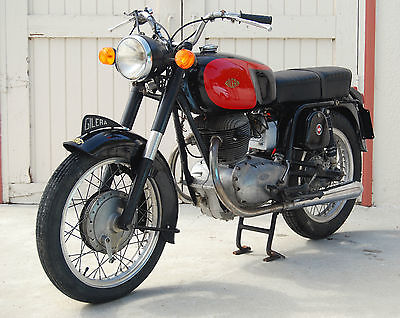$5,900
Santa Monica, California
Category
Standard Motorcycles
Engine
300
Posted Over 1 Month
In Barn-Find original condition! 1967 Gilera B300 Twin Engine #: 31*6061 Frame #: 31*6061 As 1952 rolled into 1953, Italy was the land of mainly single-cylinder motorcycles. A few four-cylinder machines were about, but strictly for the racetrack. Dozens of companies made scooters and little motorbikes, like the Ducati 65 and MV Agusta 98, and there were even a couple of big 500 singles, notably the Moto Guzzi Falcone and Gilera Saturno. Several small twins were on the market, such as the Rumi two-stroke Sport 125 and the Drusiani four-stroke Comet 175, but in the main, singles were in favor. They were cheaper to make and sell, for starters; Italians needed basic transportation in the 1950s, not performance. Also, the government granted a large tax break to purchasers of small-displacement (175cc and under) machines, so there was little impetus to build larger ones. However, this grated on all those Italian engineers whose motorcycles were winning races all over Europe. In 1952 Italian machines had won the 125, 250 and 500 world road-racing championships, Gilera taking the 500cc title with its DOHC in-line four. With a 500cc championship on display, Gilera decided to build a sportier utility bike. In the fall of ’52 Gilera presented its prototype of the B300, a cheerfully competent parallel twin—B for bi-cilindro, or two cylinders. Since the parallel cylinders were inclined forward 10 degrees, it could not be accused of copying the British vertical twins. The B300 used a unit-construction engine, enclosing the four-speed transmission, a much more modern notion than having a remote gearbox. A duplex primary chain ran the power from the crankshaft to the multiplate clutch, which was bathed in oil. Bore and stroke for each cylinder was 60 x 54mm, for a total of 305.3cc. A single camshaft at the front of the engine operated the four valves, with the tried-and-true nut and screw adjusters for setting tappet clearances. The pistons rose and fell side by side in the traditional 360-degree firing fashion of parallel twins. A single 20mm Dell’Orto carburetor took the gas from the four-gallon tank, mixed it with the appropriate amount of air and fed the fuel into the cylinders, where it was compressed at a rate of 6 to 1—Italian gasoline in those post-war years was of the low-octane variety. The spent fumes passed through a pair of shiny header pipes to the rather elegant chromed mufflers. The result of all this was a claimed horsepower of 12.5 at 5,800 rpm. This was a workaday engine, intended for reliability rather than performance, and was mated to a modern chassis using what the Italians called a duplex “open” frame. Two steel tubes came down from the steering head to the front of the engine, with the two mid-frame tubes securing the rear. As we say today, the motor was a stressed member. The rear suspension used a swingarm with Sturcher shock absorbers; the front was a Gilera-made telescoping fork. Wheels were both 18-inchers, with a 3.00 tire on the front, 3.25 at the back, both having 6-inch single-leading-shoe full-drum brakes. Dry weight was a modest 303 pounds. The kickstarter was on the right side, as was the gear-shift lever. The middling-twin prototype was received so enthusiastically that Gilera apparently accelerated the production schedule—the first ones to be sold being listed as 1954 models. Styling was very Italian, with a smoothly sculpted gas tank; a sprung solo saddle added to rider comfort, and an optional passenger pad could be affixed to the luggage rack on the rear fender. However, in the spirit of togetherness a dual seat was soon available. Minor changes were made in the B300 for the 1964 model year. Nothing radical, just a little more compression, a bumpier camshaft and now 15.5 horsepower at 6,500 rpm. The B300 remained in production until 1969. The bike offered here is a good, solid numbers-matching example of this rare piece of Italian style. The odometer reads 13,373 kms or 8,291 miles and I have little doubt from the overall condition of the bike that it is the original mileage. I have not attempted to start it, though it has good compression. The gearbox shifts through the gears, brakes seem to work, rear suspension feels good, but the front will need a rebuild. The paint on the tank looks original, as does the finish on the frame and fenders. Wheels and all cycle parts seem to be original. I don't think this bike has ever been apart. The rear indicators accompany the bike. Generally, it is in good, original condition, but it will need a fair amount of re-commissioning to be a reliable rider. Sold on a Bill of Sale.
Trim RARE







